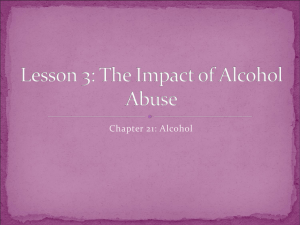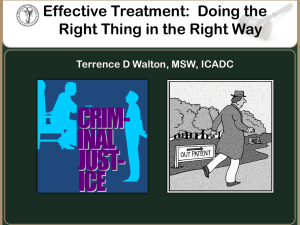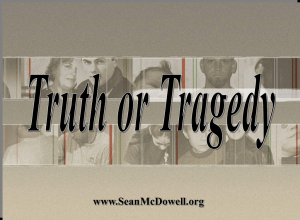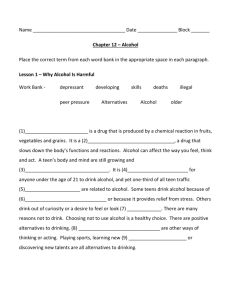Alcoholics Anonymous - Students, Alumni and Friends
advertisement
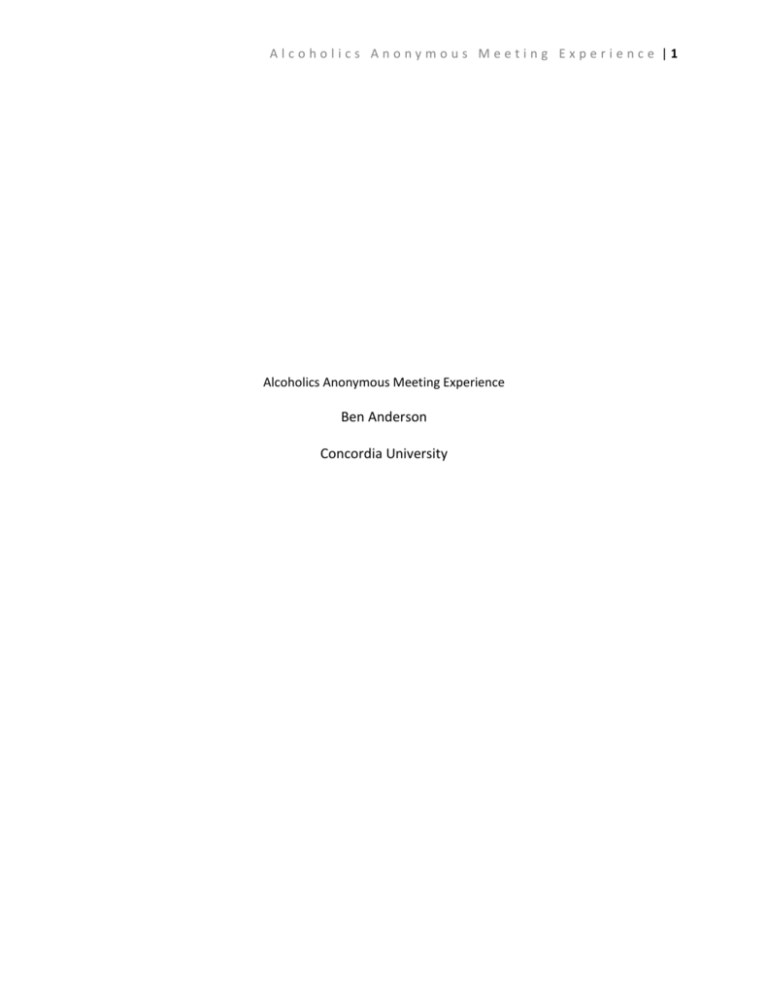
Alcoholics Anonymous Meeting Experience |1 Alcoholics Anonymous Meeting Experience Ben Anderson Concordia University Alcoholics Anonymous Meeting Experience |2 For this assignment, I decided to try out an Alcoholic Anonymous meeting. To hunt down the meeting, I went to their website and then was transferred to a specific website that was tailored to the city that I live in. Once, I was on that website, I was able to find a meeting for each day of that week, that met all throughout the city, and that had unique qualifications for each meeting. I chose to attend an open meeting, which meant that anyone was able to come and wasn’t qualified by age, gender, race, or other factors. This choice allowed me to be a part of a meeting at the local community college. I honestly felt very uncomfortable about the whole thing. The information on the website just listed a room number- L404, and since I was unfamiliar with the campus, I knew this would be an issue. 11:30am was the time that I departed, so that I could hopefully find the room before the 12:00pm start time. I was able to find a spot in the parking lot with about twenty minutes to spare and started walking towards the front doors. Many students brushed past me, they obviously knew where they were going, and I probably obviously looked like I was lost. Finally, I was able, with about three minutes before the start time, to hunt down the class room. On the front door was a sign that said, “Live and Let Live.” This was the “cover” name for the AA group. A little room probably 10’ x 20’ greeted me along with a lady in her 60’s, a younger girl who later would inform that group that she was 17, a younger guy who had migrated to the United States from Turkey, and a very quiet student who seemed to be a mixture of Hispanic and Native American. Alcoholics Anonymous Meeting Experience |3 Sitting down, I started playing the role of the first time visitor. I sat in silence until I was addressed, and I probably felt a lot of the similar experience that a first time visitor would have: I felt out of place, wondered what other people thought about me and my story, questioned the preexisting relationships of these people, along with many other thoughts that I perceive would come for a first time visitor. For the most part I sat in silence waiting for someone to acknowledge me, though I was hoping that I would go the entire session just observing and ignored. That ended quickly when the two veterans entered the room- a African-American man in his mid-forties and a white woman in her mid-thirties. The man offered his name and shook my hand, and the lady asked immediately if it was my first time, which I responded that it was my first time at a meeting like this, and that I was hoping just to observe. My goal was to not acknowledge myself as a fraud, nor admit falsely that I was an alcoholic. The meeting started up a little after noon, by the lady that I perceived was in her sixties. She had white hair and name tag for the community college, so it was natural for me to think that she was in charge. They started off by handing out three sheets of paper; I actually got one but declined, for reasons that I was new and was hoping to not participate today. They politely agreed and handed it off to someone else. This followed by everyone in the group stating their names. It sounded a lot like what you would see on TV or a movie, when TV shows reference AA meetings or addiction meetings, “My name is Ben, and I am an alcoholic.” It sounded a lot like that, but there was an additional qualifier to that statement that I don’t remember at the moment. After each person would introduce themselves, the group would say, “Hi, Alcoholics Anonymous Meeting Experience |4 whomever.” For someone who is new, I feel like this would be an uncomfortable experience as it was for me. I didn’t know to use the full statement when it got to me, so I just say, “My name is Ben.” This was followed, but an open time of sharing past successes. Before anyone spoke, they would say their name and their issue. Two people went through this process and stated their current success, which was followed by applause from everyone else in the room. At this time, the sheets that were handed out were read through. The readings basically went through the purpose of the meetings, the dangers of alcohol, and the basic premise of how to overcome this affliction. After these papers were read, the oldest lady read a short devotional that was tailored to alcoholics, followed by the youngest girl reading from what they referred to as “The Big Book”. Basically, I surmised that this “big book” would be very similar to a Bible for alcoholics. The reading from the Big Book shared a personal story of pain and anguish as it shared how the individual went through their own issues with alcoholism and how their lives spiraled down and then were built back slowly through proper coping mechanisms. A Bible study experience followed this as the individuals in the room talked about the story and interacted with it on a personal level. Everyone in the room, besides me and the Hispanic/Native American young man shared during this time. The African-American gentleman connected with the part in the book that referred to the shame and embarrassment of falling into this trap along with making a connection with Alcoholics Anonymous Meeting Experience |5 how the book referred to alcoholism as a disease. That concept seemed to connect with everyone in the room. They connected that they felt helpless against alcohol much like a person with cancer feels helpless. He began to dig into that idea a little bit more talking about his personal experience, how he lost his job, money, and family as alcohol had taken a strong foothold in his life. The connection to alcoholism as a disease was made by him again as he told of his successes. He felt that alcoholism has always been and will always be a part of him, but that he needs to suppress it and discussed how this program had helped him suppress his disease. His sharing seemed to touch the heart of the seventeen year old girl, because she began to cry and tell how she felt helpless against the power of alcohol. She told how she was currently trying to get her G.E.D., because her fight with alcohol got her thrown into a rehab facility when she was in high school. Her tears and her emotions gave some insight that this was something she was definitely still struggling with and terrified how it might negatively impact her life. The sharing of stories continued, as the mid-forties lady told her story. Vodka was her poison of choice. It was something that she said she loved. She would drink until she blacked out, and she loved it. Her story unfolded into tragedy as she told of the ups and downs of her struggle. At the moment, her biggest issue was that today was her daughter’s birthday, and she had just turned 21. The lady felt certain that her struggle would genetically be her daughter’s struggle as she sited patterns in her family dynamics. Alcoholics Anonymous Meeting Experience |6 This prompted the lady in her sixties to talk about the pattern of alcohol in her family structure. Twelve was the age she first started drinking heavily, and everyone in her family had patterns of drunkenness. She couldn’t recall a relative that was sober, until her brother who helps run the AA program in Des Moines, got clean and started in the AA program. The guy from Turkey was the next to chime in as he spoke about how when he moved from Turkey to the United States, he found his acceptance was based around drinking. This led him down a path heavy drinking, fake friendships, and loss in all areas of his life. He spoke how he was able to overcome the drinking by changing his location and finding new friends. All of theme seemed to come to the general idea that the program was affective, and they wanted anyone who had problems with drinking to be a part of it, so that they didn’t have the same issues creep into their lives that they had experienced. It seemed very much like they were not only discussing their issues but having a mini intervention for us newcomers or quiet ones. After our interaction with the big book and stories, we read a group of promises that each person was to take a hold of. These promises pointed to what life would be like if the person would commit to removing alcohol from their lives. The meeting ended with the Lord ’s Prayer and extra socializing for some of the people who were taking part in the program. They let me know that they were hoping I would return to help with my issues. I actually enjoyed my time with this group, though at first, I felt uncomfortable. They seemed very friendly and genuine. They wanted me to get better and be a part of their Alcoholics Anonymous Meeting Experience |7 community. I can definitely see where that would be an attractive to many people. New concepts and thoughts were definitely learned from my experience with this group. Three major ideas and concepts stood out to me. One, they want someone to talk to who isn’t judgmental and who has probably experienced something that they are going through. Two, they make it a point to have accountability partners and other community members to keep each other on the straight and narrow. Three, they really care and are concerned for each other; it seems to be a very real and honest environment. This experience gave me more insight into how I would deal with somebody who is struggling with these issues. In the case of someone, who I know, calling me and asking me to help them because they were an alcoholic, I could use this insight and other insight (including personal experiences and thoughts from books such as Josh McDowell’s book Handbook on Counseling Youth) to help impact their lives for the better. In order to help someone along this path as a helper, I would follow the acronym laid out in McDowell’s book- L.E.A.D.E.R. or stated with its meaning- Listen, Empathize, Affirm, Direct, Enlist, and Refer (McDowell, 1996., 395-396). The first step is simply to listen. A major piece that I got out of the AA meeting was that group felt mutually judged by those who have not experienced such difficulties; they felt that those people felt that stopping was an easy process and that the helper couldn’t relate at all. With this in mind, we simply just want to stop and listen. I would open up by letting them know that this is a safe place where no one is here to judge, that we have all fallen short, and that we Alcoholics Anonymous Meeting Experience |8 just want to hear the story. This would be followed by an active listening session where we would not only listen to the verbal but look at the nonverbal (McDowell, 1996., 395). Attempting to see beyond the words and actions will be next as we begin to empathize with the individual. Our focus during this time should be to imagine how the individual is thinking or feeling, and our focus should not be in correcting the behavior at the moment (McDowell, 1996., 395). During the AA meeting, I saw this play out as members told similar stories and acknowledged the similar struggles and pains with the other members. This was followed by more people following in that pattern as they felt willing to open up. Affirmation would follow this, as we express our acceptance and appreciation of the individual as a person (McDowell, 1996., 395). As helpers we want to continue to separate the individual’s value from the issues that they are facing. This will allow them to connect to the helper along with aiding them to begin to disconnect from the behavior. In the AA meeting, this next part would be very similar to the 12 steps that were mentioned. In this format, it is called- direct. The helper must offer direction or a way out. McDowell offers four parts to his direct portion of his book: 1- Gently but firmly guide the young person to recognize and admit the problem, 2- Turn the person toward God, 3- Inform and involve family or close friends, 4- Review options for treatment (McDowell, 1996., 395396). The key point that I saw in the AA meeting and in this process is the admitting part. For the person mentioned in our scenario, they have admitted having problems. Once they have admitted they have a problem, they obviously want a solution, or they wouldn’t have brought it Alcoholics Anonymous Meeting Experience |9 up. This allows the helper to start walking through the process with the individual in need and begin partnering with them for a solution. Enlist is the next part of the puzzle. This involves working on a solution with the troubled person. As a helper we can offer gentle prodding and guidance, but as much as possible, we want the individual to participate and own a portion of the resolution (McDowell, 1996., 396). The last part of the acronym is essential- refer. We should never underestimate the issues going on here and overestimate our abilities. The bottom line is that these are complex issues, and it is important to have a professional counselor available to connect these students to. We should never let the alcoholic struggle through this without professional help (McDowell, 1996., 396). Another situation that might pop up is someone coming to you as the helper to get ideas for an intervention for an alcoholic from a friend or family member. At this point in time, I feel it would be important to walk that individual through the L.E.A.D.E.R. steps, but first I would have the person, seeking to set up the intervention, walk me through their experiences and the story as they know it. This might bring to light insight on how to approach this unique situation or if this is even the best possible route. The last thing that we want to do is alienate the alcoholic by intervening in such a public way, when another route might be more ideal. A l c o h o l i c s A n o n y m o u s M e e t i n g E x p e r i e n c e | 10 After discussing the story and analyzing whether this was the best route to take, I would proceed in walking the individual through the L.E.A.D.E.R. process focusing mainly on: Listen, Emphasize, and Affirm (McDowell, 1996., 395). For the most part, I don’t think family members are equipped, at that moment, to dive into the rest of that model. For the most part their focus should be to show their love, acceptance, and support for the individual who needs help. It would be wise to have those individual in the community group share their own personal struggles in this area, discussing the ups and downs and ultimate repression of these issues through help. I would strongly encourage them to enlist help (whether it is the helper, AA, or professional counselor). That person needs support from their family and acceptance, but their original direction or help should come from a neutral source. There is definitely a lot to be learned from all of these experiences: the meeting, studying, and life experience. We should be continually striving to learn and put ourselves in these hypothetical situations, so that we are prepared to help those in need. A l c o h o l i c s A n o n y m o u s M e e t i n g E x p e r i e n c e | 11 Resources: McDowell, Josh, and Bob Hostetler. Josh McDowell's Handbook on Counseling Youth: A Comprehensive Guide for Equipping Youth Workers, Pastors, Teachers, and Parents. Dallas: Word Pub., 1996. Print.
